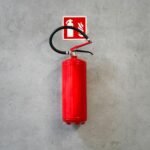Contents
ToggleSafety Protocols in Electrical Installations
Ensuring safety in electrical installations is critical to protecting both building occupants and maintenance personnel from potential hazards. Following established safety protocols in line with Indian Standards (IS) and the National Building Code (NBC) significantly reduces risks such as electric shocks, fires, and equipment failures.
1. Earthing and Grounding: IS 3043
Proper earthing and grounding are vital for mitigating electrical hazards. According to IS 3043:2015, these practices help safely dissipate excess electrical current into the ground during faults, reducing the risk of shocks and fires.
- Purpose of Earthing: Diverts fault current into the ground, preventing potential hazards to life and property.
- Earthing Techniques: Depending on soil resistivity and building requirements, methods like plate earthing, rod earthing, and strip earthing are employed.
- Maintenance: Routine inspections and testing are essential to ensure earthing systems meet acceptable resistance levels, as recommended by IS 3043.
2. Overload and Short Circuit Protection: IS 8623, IS 3854
To prevent fires and equipment damage, circuit protection devices are indispensable. IS 8623 and IS 3854 specify the safety and performance standards for devices like circuit breakers and fuses.
- Types of Circuit Breakers: Devices such as Miniature Circuit Breakers (MCBs) and Molded Case Circuit Breakers (MCCBs) are used based on load capacities and voltage requirements.
- Regular Testing: Periodic testing and calibration ensure circuit breakers function correctly, minimizing risks during overloads or short circuits.
3. Personal Protective Equipment (PPE) and Safe Work Practices
Electricians and maintenance personnel must use appropriate PPE and follow stringent safety protocols when handling live systems or ungrounded equipment.
- PPE Essentials: Insulated gloves, helmets, safety goggles, and arc-rated clothing provide protection against electrical hazards.
- Lockout/Tagout (LOTO): Implementing LOTO procedures prevents accidental energization of equipment during maintenance, enhancing workplace safety.
4. Fire Safety Measures: IS 1646 and NBC
Electrical systems pose a fire hazard, making fire safety measures imperative. IS 1646 and NBC standards outline steps to prevent and manage electrical fires effectively.
- Flame-Retardant Materials: Use of flame-retardant wires and insulation minimizes fire spread.
- Fire Suppression Systems: Installing fire extinguishers, smoke detectors, and suppression systems near electrical panels ensures quick response to incidents.
- Emergency Preparedness: NBC mandates clear evacuation routes and emergency lighting systems to ensure safety during power outages or fires.
5. Testing and Commissioning Procedures
Before electrical systems are commissioned, rigorous testing is essential to ensure safety and reliability. Standards like IS 732 and IS 13703 provide detailed guidelines for testing protocols.
- Insulation Resistance Testing: Detects faults in insulation to prevent leakage or short circuits.
- Continuity Testing: Verifies unbroken, secure connections for consistent power flow.
- Functional Testing: Ensures equipment such as circuit breakers and transformers perform reliably under load conditions.
6. Documentation and Safety Audits
Comprehensive documentation and regular audits play a crucial role in maintaining safety and compliance with regulations.
- Detailed Records: Maintain up-to-date wiring diagrams, safety procedures, and test reports to aid troubleshooting and regulatory compliance.
- Periodic Audits: Certified professionals should perform regular safety audits to identify potential risks and verify adherence to IS standards.
Conclusion
Implementing robust safety protocols in electrical installations is vital for minimizing risks and ensuring smooth operation. By adhering to IS standards and best practices, engineers and electricians can design systems that prioritize safety and reliability. Measures like earthing, overload protection, PPE usage, fire prevention, and detailed testing create secure and efficient installations. Additionally, consistent audits and thorough documentation ensure long-term safety and functionality.










